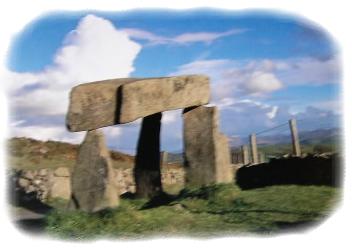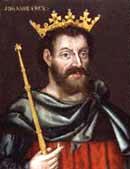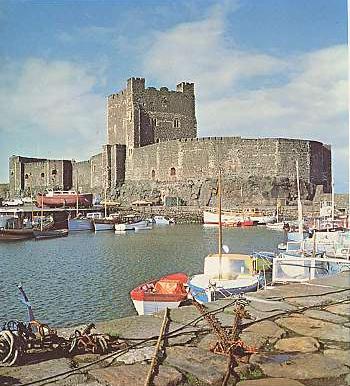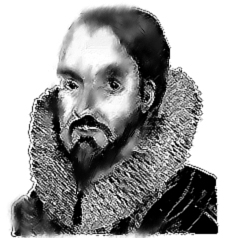A Brief History of County Down. |
Samuel Lewis' History of Down |
| |
| The
countryside of County Around 400 AD the Fiatach controlled what is now Counties Louth, Down, as well as parts of both Armagh and Tyrone, from the 9th century on Bangor became the favoured site of the kings The area of land now known as Lecale whish stretches from Downpatrick to Ardglass and towards Dundrum, was ruled by a junior branch of the Fiatach it was known as Leth Cathail (Cathal's half) from which Lecale derives its name The Dand aacute;l Fiatach and the Ulidians who became known as the Red Branch of Ulster, ruled all of Ulster from Emain Macha, (County Armagh) they are the ones who featured in the Ulster Cycle, with characters such as King Conchobhar (Conor) mac Nessa, CuChullain, Fergus and Sualtam mac Roth. They were prominent in the Cattle Raid of Cooley, but were later to be displaced as rulers of all Ulster by the Ui Neill Clan, which invaded from Connaught and Meath. The Red Branch were left in control of Counties Antrim and Down, the Kingdom of the Uluti or Ulstermen, known as Ulaidh or Ulidia who lend their name to the Ulster of today. The native tribes remained in control of County Down until the arrival of the Normans, in 1177 John de Courcy defeated the last of the MacDonslevy kings at Downpatrick in County Down. St Patrick landed in east County Down in 432 AD, it was at Saul near Downpatrick he built his first church and began his mission to convert Ireland. The county has a special association with him, he is said to be buried in the grounds of Downpatrick Cathedral. The cathedral stands on a mound overlooking the town, which takes its name from the Irish Dun Phadraig (Patrick's Fort). The first cathedral to stand on the site was burned down, and the present one dates from the 1100's, although it has undergone many modifications in the intervening centuries. In early Christian times, there were important monastic centre's at Aondruim (Nendrum), Dun Leathghlaise (Downpatrick) Magh Bhile (Movilla, Newtownards) Beannchair (Bangor) Rath Murbholg (Maghera), Druim Mand oacute;r (Dromore), Domhnach Mand oacute;r (Donaghmore) and Linn Duachaill (Magheralin) The first Viking raid on Ireland was recorded in 795, during the early 800's Down was attacked many times and its monasteries plundered, the Ulaid of County Down had a strong naval tradition and were often successful in repulsing these raids, which perhaps explains why the Vikings don't appear to have established any enduring settlements in the area, although a high status Viking burial has been found at Balyhome just south of Bangor, the area unlike orther parts of Ireland has few place names which can be attributed a Norse origin, save for the sea loughs of Carlingford and Strangford. In 926 Muirchertach, son of Niall Glendubh defeated the Vikings in a sea battle on Strangford Lough. Muirchertach's base was in the The Grianan of Aileach, County Donegal during his reign he defeated the Vikings on many occasions, both in Ireland and the Scottish west coast, before being killed in the Battle of Ardee in 943. (See chronology for list of Viking raids.) The Arrival of the Normans. In
1177 eastern Ulster was invaded Upon his arrival the Irish chief in the area came to welcome and pay homage to him, .John appears to have derided his Irish subjects, it is said that their beards were rudely pulled in reticule, by the clean shaven members of John's retinue. The ever proud and sensitive Irish withdrew and took their grievance's to the Kings in the west and south of Ireland, with the result that John's visit to Ireland was a disastrous failure and he returned to England on 17th December. Life to De Courcy was perpetual warfare The years between 1197 and 1199 were spent in unending conflict with the Irish and building castles to keep them in check. De Courcy became embittered in 1197 when his brother Jordan was killed by an Irishman of his household. He avenged his brothers death on some petty chief's and gave large tracts of their land to a Scotsman named Duncan Galloway who aided him. There appears to have been a Scottish settlement near Coleraine where large grants of land were given to the Scots of Galloway. De Courcys rule in Ulster seems to have aroused envy in Hugh de Lacy, who perhaps misrepresented De Courcy to John as destroying the Kings land in Ireland, at this time De Courcy was minting his own coinage, so possibly he had designs on an independent Kingdom. In 1201 De Courcy was arrested by De Lacy but was released when his followers agreed not to Plunder De Lacy lands in future. Two years later in 1203 De Lacy came north again and defeated him in a battle at Downpatrick, banishing him from Ulster. On 31st August 1204 De Courcy was summoned to appear before King John, and 'as he had sworn and given hostages to do', in default his lands were to be confiscated. De Lacy returned north again and after a struggle took De Courcy prisoner. He was again set free on condition that he went to the holy land. Again he did not comply. The King's patience exhausted on the 29th may 1205 he granted to Hugh de Lacy all the lands of Ulster, to hold to the King in fee, and created De Lacy Earl of Ulster. |
||
|
|
| |
| By
1210 John was King and de Lacy has fallen from his favour, John landed
at Waterford on 20th June with de Courcy, From The History of Ulster by Ramsey Colles LLD MRIA F.R. Hist.S. |
||
|
|
The
Plantation. |
||
| There was an unsuccessful attempt to plant Ulster in 1569 when Sir Thomas Smith tried to bring English settlers into the Ards Peninsular and County Down. He may have made more than one attempt as another source gives his arrival date as August 1572, August was not a prudent time of the year to embark upon a plantation, to survive the oncoming winter shelter is needed, food stocks are required for almost a full year until the following years crops have been planted and harvested. In 1569 Brian ONeill burnt Movilla and other monasteries in County Down, to deprive Smith and his settlers of shelter. The major Ulster chieftain at the time Hugh ONeill, began a general rebellion in Ulster in 1594, the English response to this was to adopt a scorched earth policy. It was not until 1607 after the Flight of the Earls, that the plantation of Ulster began in earnest, thousands of settlers were brought to the Provence adventurers such as Annesleu, (Mourne) Hill (North Down) and Montgomery and Hamilton (Ards) these men were granted large tracts of land if they brought in a specified number of settlers to their estates. Scottish settlers such as James Hamilton who brought 10,000 settlers to north western Ulster, bringing with them the language and culture of the Scottish Lowlands to the county of Down. The Hamilton and Montgomery estates shared a common boundary, the location of which appears to have been constantly in dispute, the pair eventually resorting to litigation. Many
accounts of the plantations of the late 16th early 17th centuries This scorched earth policy was employed across Ireland by the Lord Deputy Lord Mountjoy (Charles Blonc) and Carew in Munster it was largly responsible for the defeat of the Irish Clans, and ultimately resulted in The Flight of the Earls. It is interesting to note that many of the protestant planters brought to Ireland may not have been there of theit own choice, to get a grant of land you first of all had to be well connected to the rulers of the time, this precluded the vast majority of the population. You had to undertake to plant the land with a given number of people and build a fortified house or castle, these people became known as Undertakers. The were for the most part people who already had estates in England, so they would have said to some of their tennants there I am going to Ireland would you like to come with me and I will rent you some land on which to build a house, you can then start a new life there as a tennant of mine, If they said no they would probably have been told to move on. In 1641 a general rebellion broke out in Ireland, this was in some way precipitated by events in England where Charles I was in conflict with his parliament, this led to civil war in England. The Irish rebellion was led by Sir Phelim ONeill, his cousin Owen Roe ONeill who left Ireland as a child with the 'Flight of the Earls' joined him in the struggle. The ONeill's were the Gaelic lords of Ulster, their dynasty founded by Nial of the Nine Hostages, in the fifth century AD. They struggled for nine years but were finally defeated when the English puritan Oliver Cromwell brought his army to Ireland in 1649 and crushed the rebellion with great ruthlessness. A mere forty years were to pass before Ireland was to be again bathed in blood, as a result of political maneuvering in England and Europe, the consequences of the Williamite wars manifest themselves in Northern Ireland to this day, its population, becoming victims of history, polarized by the power struggles of egocentric Kings and Lords of three centuries past, who in war saw not the widows and orphans, they left destitute in the various theatres of conflict, their interest lying only in the perpetuation of their often corrupt regimes. Such was the Williamite war, James II of England was deposed by his parliament, they invited William III (King Billy) of the Netherlands who was married to James daughter Mary, to become king of England. James fled to France seeking the help of Louis XIV. James realised if he could persuade mainly Catholic Ireland to rebel against the English, it would be the first step to regaining his throne. He proceeded to Ireland and convened a parliament in Dublin and announced his intension if victorious he would reinstating all the land confiscated by the English to its original Gaelic owners. Philip of Spain is reported to have said around the time of the Armada in 1588 and "He who holds the key to Ireland, holds the key to England's door." James marched his army to Londonderry where he unsuccessfully besieged the city for three months. On August 13th.1689 Marshal Schomberg disembarked 10,000 troops together with heavy artillery from seventy transport ships at Groomsport Co Down to defend the Williamite cause in Ireland. On Saturday 14th June 1690 William III lands with his army at Carrickfergus (Co Antrim) he marched south to Droheda in County Louth where with a superior army he defeated James at the Battle of the Boyne James left Ireland a few days later. The following year the descivise battle in the conflict took place on the 12th July at Aughram County Galway, the Jacobite army was defeated, the battle is said to have been the bloodiest in Irish history leaving over seven thousand dead. |
||
|
|
The
1798 Rebellion. |
||
| In 1798 Ballynahinch was the scene of a determined stand by Presbyterian rebels against the British Army. Soon afterward, the north and east of Down became noted for strong loyalty to the United Kingdom. South Down, where the population is mainly Roman Catholic, has much support for Irish nationalism. See also the Chronology of Ireland and history of Ireland. |
||
|
|



 by Anglo Norman barons
led by John de Courcy, initially he built some thirty Motte and Bailie
castles to retain and consolidate his grip on the country, eventually
he came to control most of eastern Ulster, and built stone castles at
by Anglo Norman barons
led by John de Courcy, initially he built some thirty Motte and Bailie
castles to retain and consolidate his grip on the country, eventually
he came to control most of eastern Ulster, and built stone castles at
 they were joined by
Justiciar, John de Gray, bishop of Norwich and a body of Irish troops.
They pursued De Lacy northwards and were at Dundalk on the 8th July
where 400 of de Lacys soldiers who had deserted him. De Lacys men destroyed
and set fire to their castle's in the county, De Lacy fled to
they were joined by
Justiciar, John de Gray, bishop of Norwich and a body of Irish troops.
They pursued De Lacy northwards and were at Dundalk on the 8th July
where 400 of de Lacys soldiers who had deserted him. De Lacys men destroyed
and set fire to their castle's in the county, De Lacy fled to  relate that the English
and Scottish settlers encountered a barren uncared for land devoid of
population. This is undoudtably true, the reason being that previously
relate that the English
and Scottish settlers encountered a barren uncared for land devoid of
population. This is undoudtably true, the reason being that previously